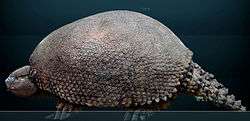Glyptotherium
| Glyptotherium Temporal range: Pleistocene | |
|---|---|
 | |
| G. arizonae | |
| Fossil | |
| Scientific classification | |
| Kingdom: | Animalia |
| Phylum: | Chordata |
| Class: | Mammalia |
| Superorder: | Xenarthra |
| Order: | Cingulata |
| Family: | Chlamyphoridae |
| Subfamily: | †Glyptodontinae |
| Genus: | †Glyptotherium |
| Species | |
| |
Glyptotherium is an extinct genus of glyptodont, a group of extinct mammals related to the armadillo living from 4.1 to 1.5 million years ago (AEO). The genus is considered an example of North American megafauna, of which most have become extinct. Glyptotherium may have been wiped out by climate change or human interference.
Like its living relative, the armadillo, Glyptotherium had a shell which covered its entire body, similar to a turtle. However, unlike a turtle's shell, the Glyptotherium shell was made up of hundreds of small six-sided scales. Some species grew up to six feet long and its armor weighed up to a ton.
Remains of Glyptotherium species have been found in tropical and subtropical regions of Venezuela, Central America, Mexico, and the southern United States from Florida and South Carolina to Arizona.[1] There is no direct evidence of humans preying on the North American glyptodont. Smilodon however, may have occasionally hunted Glyptotherium, based on a skull bearing puncture marks consistent with the size and shape of Smilodon's saber teeth, indicating the cat had successfully risked biting into bone to kill the armored herbivore.[2]
Glyptotherium was named by Osborn in 1903, assigned to Glyptodontinae by Downing and White in 1995 and to Glyptodontidae by Osborn (1903), Brown (1912), Carroll (1988), Cisneros (2005) and Mead et al. (2007).
Gallery
 Restoration
Restoration- G. texanum skull
See also
References
- ↑ "Glyptotherium Osborn 1903". Paleobiology Database. Retrieved 2014-09-09.
- ↑ Anton, Mauricio (2013). Sabertooth.
- "AMNH Bestiary". Retrieved 2006-06-18.
| Wikimedia Commons has media related to Glyptodontidae. |